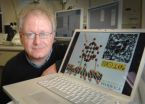NPL builds long range alpha detector
2010-11-02
(Press-News.org) The UK's National Physical Laboratory (NPL) has developed a new portable radiation detector that can assess the safety of potentially contaminated areas far quicker than current methods. The prototype was inspired by the aftermath of the murder of Alexander Litvinenko in London 2006.
Litvinenko's death was due to radiation poisoning from polonium-210. It prompted wide-scale work to assess radiation levels at almost 50 premises in London that he had been prior to his death before opening them up again to the public, costing the Health Protection Agency £2 million.
The clean up process took an extended period of time as scintillation counters were used to detect alpha particles and therefore measure the radiation levels. Alpha particles only have a range of about 2 cm and can be suppressed by surface moisture and roughness. Geiger counters also require a skilled operator to work, making it a painstaking and laborious process to scan wide areas very close to the surface.
NPL has developed a prototype device which can detect the optical photons generated by alpha particles in air, thus having a far greater range.
Alpha particles can cause ionization of nitrogen in air, which in turn produces fluorescence photons that show up as discrete spectral lines in the UV band of the electromagnetic spectrum. These photons can travel much further than alpha particles and are not hindered by surface particles or roughness and can be transmitted through any UV transparent material such as plastic or glass. This means an area could be made safe before a contamination assessment is carried out.
NPL has developed a portable device for low-level monitoring in normal lighting conditions. Laboratory tests have shown that the prototype is capable of detecting alpha induced nitrogen fluorescence at distances greater than the range of alpha particles (2 cm). The prototype has demonstrated detection up to 20 cm, limited currently by the optics on the device. However, the principle is completely scaleable with small devices having a range of cms and non-portable devices reaching kms.
Ray Chegwin, Business Development Manager at NPL, said:
"NPL has a strong heritage of using world class measurement science to benefit society and industry in the UK and beyond. By producing a prototype that can measure radiation up to ten times further away than current methods we can greatly improve the time it takes to safely assess any suspected radioactive areas. Our prototype could have saved the time it took to monitor the areas relevant to the Litvinenko case, and cut the costs of such an essential operation. Of course, the detector could be used to support radiation safety and decommissioning operations in the nuclear industry, amongst others, and we're currently investigating these."
INFORMATION:
Notes to editors
About the NPL Alpha Detector:
The spectral range of the fluorescence photons emitted due to alpha ionisation of nitrogen are located in the predominantly UV range (300 – 490 nm) of the optical spectrum. Tests have been carried out to eliminate any possibility of the detected signal coming from beta or gamma radiation.
The device can operate in a sodium lamp room. In this environment, the light levels are similar to normal room light levels (lights on). The filtered detector is entirely blind to the wavelength of light emitted by sodium lights. The detector is also capable of detecting the fluorescence signal through any UV transparent material.
The optical housing has been designed so that any 1-inch optics can be inserted to select particular wavelengths. The device is modular; adapters could be made for larger optics, larger area detectors can also be used. Custom electronics have been designed and implemented to make the device portable. A lithium ion battery provides up to 8 hours of usage in field-based applications.
The National Physical Laboratory
The National Physical Laboratory (NPL) in Teddington is one of the UK's leading science facilities and research centres. It is a world-leading centre of excellence in developing and applying the most accurate standards, science and technology available.
NPL occupies a unique position as the UK's National Measurement Institute and sits at the intersection between scientific discovery and real world application. Its expertise and original research have underpinned quality of life, innovation and competitiveness for UK citizens and business for more than a century:
NPL provides companies with access to world leading support and technical expertise, inspiring the absolute confidence required to realise competitive advantage from new materials, techniques and technologies
NPL expertise and services are crucial in a wide range of social applications - helping to save lives, protect the environment and enable citizens to feel safe and secure. Support in areas such as the development of advanced medical treatments and environmental monitoring helps secure a better quality of life for all
NPL develops and maintains the nation's primary measurement standards, supporting an infrastructure of traceable measurement throughout the UK and the world, to ensure accuracy and consistency.
ELSE PRESS RELEASES FROM THIS DATE:
2010-11-02
The single layer material Graphene was the subject of a Nobel prize this year but research led by a team of researchers at the University of Warwick has found molecular hooks on the surface of its close chemical cousin, Graphene Oxide, that will potentially provide massive benefits to researchers using transmission electron microscopes. They could even be used in building molecular scale mechanisms.
The research team, which includes Drs. Jeremy Sloan, Neil Wilson and PhD student Priyanka Pandey from the Department of Physics and Dr. Jon Rourke from the Department of Chemistry ...
2010-11-02
Everybody knows that if you're physically fit, you're less likely to get a wide range of diseases. What most people don't know is that some people are "naturally" in better shape than others, and this variation in conditioning makes it difficult to test for disease risk and drug effectiveness in animal models. A new research paper published in the November 2010 print issue of The FASEB Journal (http://www.faseb.org) started out as a study to explain the strong statistical link between low aerobic exercise capacity and common diseases, but ultimately led to an animal model ...
2010-11-02
When looking for new ways to treat aggressive brain cancers, an international team of scientists turned a new leaf and "discovered" the lowly daffodil. A new research study published in the November 2010 print issue of The FASEB Journal (http://www.fasebj.org) offers hope that a natural compound found in daffodil bulbs, called narciclasine, may be a powerful therapeutic against biologically aggressive forms of human brain cancers.
"We are planning to move a narciclasine derivative toward clinical trials in oncology within a three to four year period in order to help patients ...
2010-11-02
Scientists are keeping their eye on a new discovery published in the November 2011 print issue of the FASEB Journal (http://www.fasebj.org) that explains what causes some genes to go out of control. Scientists have identified a "cellular switch," called eye transformer, that controls the flow of information from chemical signals outside of the cell to genes in the cell nucleus. This study demonstrates that when eye transformer is turned off, the information pathway it controls (the "JAK/STAT pathway") hyper-activates. Because this pathway exists in humans and is involved ...
2010-11-02
ROCHESTER, Minn. -- Statistics from the Centers for Disease Control and Prevention (CDC) (http://www.cdc.gov/) rank mortality related to chronic liver disease and cirrhosis as the 12th most common cause of death in adults in the U.S. Using a modified definition that includes diseases such as viral hepatitis, liver cancer (http://www.mayoclinic.org/liver-cancer/) and obesity-related fatty liver disease (liver diseases)(http://www.mayoclinic.org/liver-disease/), Mayo Clinic-led researchers have found that liver-related mortality is as high as fourth for some age groups, and ...
2010-11-02
Tampa, Fla. (Nov. 01, 2010) – When researchers tested three different labeling agents on three different stem cell populations to determine what effect the labeling agents had on stem cell phenotype, biological behavior and migration abilities, they found changes in stem cell proliferation depending on the type of contrast agent used.
The team of researchers from Belgium and Spain tested USPIO (ultra small superparamagnetic iron oxide) contrast agents Resovist ®, Endorem ® and Sinerem ® on mouse embryonic stem cells (mESC), rat multipotent adult progenitor cells (rMAPC) ...
2010-11-02
While wind energy has shown strong potential as a large-scale, emission-free energy source, bat and bird collisions at wind turbines result in thousands of fatalities annually. Migratory bats, such as the hoary bat, are especially at risk for collision with wind turbines as they fly their routes in the forested ridges of the eastern U.S. This loss not only impacts the immediate area, but is also detrimental to ecosystem health nationwide—that is, bats help with pest management, pollination and the dispersal of numerous plant seeds.
Since turbine towers and non-spinning ...
2010-11-02
With a lifelong interest in politics, University of Cincinnati researcher Muer Yang spent the last two years developing a quantitative method for allocating voting machines that could significantly reduce the average wait time of voters.
During the 2004 U.S. presidential elections, some voters waited in lines for more than 10 hours to cast their ballots, and in Ohio, the last vote was cast at 4 a.m., noted Ohio Secretary of State Jennifer Brunner in a public report. Ohio lines in the '06 and '08 elections were still so lengthy that they essentially "disenfranchised" voters ...
2010-11-02
CAMBRIDGE, Mass., Nov. 1, 2010 -- Race may not be as important as previously thought in determining who befriends whom, suggests a new study of American college students' habits on Facebook. The findings, by a pair of sociologists from Harvard University and UCLA, appear in the current issue of the American Journal of Sociology.
The strongest attraction, the researchers found, turned out to be old-fashioned social pressure. For the average student, the tendency to reciprocate a friendly overture is seven times stronger than the attraction of a shared racial background.
"We ...
2010-11-02
Invasions of voracious predatory crabs due to global warming could threaten the unique continental-shelf ecosystems of Antarctica, according to newly published findings.
"King crabs are ecologically important predators and form the basis of economically significant commercial fisheries," said Dr Sven Thatje, an evolutionary ecologist at the University of Southampton's School of Ocean and Earth Science (SOES), which is based at the National Oceanography Centre in Southampton.
Thatje and graduate student Sally Hall studied how water temperature influences the distributions ...
LAST 30 PRESS RELEASES:
[Press-News.org] NPL builds long range alpha detector


